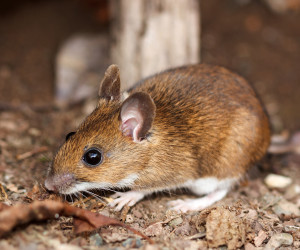Deer Mouse

Rodent Control: How to Get Rid of Deer Mice
An interior rodent control treatment consists of placing anywhere from 4-12 tamper-resistant bait stations on the inside of the structure in common travel areas for mice. These areas include attics, under stoves, under kitchen and bathroom sinks, near furnaces and hot water tanks, close to electrical panels and under stairs, always away from where pets and children may find them. We use single-feeding, rodenticide bait and it is placed in lockable bait stations. The treatment is warrantied for 90 days and can take 3-7 days to be effective.
For the most part, they will die in their nest in a wall or attic. Occasionally, a dead mouse will be found in an inconvenient location or cause a slight odour. If this happens, air fresheners or candles can help, or, if necessary, we can supply you with odour absorbing bags. This does not happen very often.
Call us to discuss our rodent control options.
How to Identify a Deer Mice Infestation
- The deer mouse is brown or grey with a white belly and feet. The white colour on the underside of its tail is an easy way to spot a deer mouse
- They are round and slender, ranging from 7 to 10 cm long in body length with a pointed nose and large, black beady eyes
- It may invade buildings near fields and woodlands in the fall
- Their tail is short, distinctly bicolored (dark on top and light on bottom), and covered with short, fine hairs and can be 5 to 13 cm in length
- In winter, deer mice enter domestic spaces in search of food and warmth. Their nests are constructed of fur, weeds, seed and paper
- Sightings of deer mice as well as their nests or gnawed objects are main signs of deer mouse activity
How to Prevent a Deer Mice Infestation
- To prevent mice from entering the home, all cracks, crevices, holes and gaps larger than a pen cap should be sealed with cement or a mixing compound
- Cleanliness may also have an effect on pest infestations. Be sure to wash dishes immediately following use
- Food should be stored in glass or metal containers with tight lids
- Remove cozy nesting sites in unused clutter around your house and garage
- Cut tall grass and weeds back from your house
Possible Health Concerns
- The deer mouse is the most common carrier of the deadly Hantavirus
- Hantavirus pulmonary syndrome can develop from inhaling the virus when deer mouse urine or feces is disturbed
About Deer Mice
- Despite their tiny bodies, mice eat between 15 and 20 times a day
- Mice typically enter our homes between October and February, looking for food, water and shelter from the cold
- Mice are usually nocturnal animals. They have poor eyesight but make up for this with their very good hearing and smell

